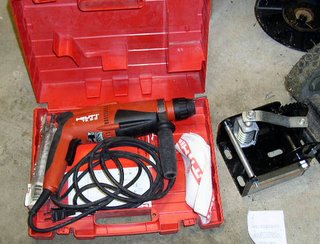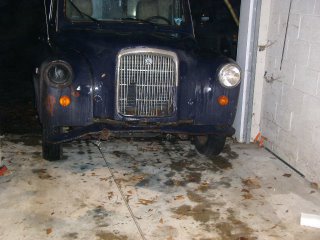There isn't enough room in my garage to work on the bomb. The left doors hit the wall. The bonnet hits the ceiling. With the left rear tire still flat, I had to use my car to drag the thing out. Out was fine, but a BMW is a little big to drag the bomb back into the garage. MLK day I ran out to
Harbor Freight in search of a cheap solution. I picked up a pair of vehicle dollies and a cheap winch. The dolly would go under the flat tire so the bomb could roll. The winch was a back-up if we coudn't push the bomb on the dollies.
By the time I got home it had started raining. Not good. The bomb is missing the driver's window. Well some of it anyway. There are small bits of it scattered around.
I unpacked the dollies, put them together and jacked up the left rear. My poor excuse of a jack couldn't lift the wheel high enough to slip the dolly in. Just as well, I doubt the HF dolly would hold up to the stress. My friend Herman called Harbor Freight "the store with the lead wrenches." Their products are terrible.
At this point the rain was really coming down. I was getting soaked. Time to move into the garage and try plan B,
the winch.
 I used my Hilti hammer drill and set 3 large anchors in the garage floor. Four years ago when I installed a new kitchen range, I was terribly guilty about buying an expensive tool for a single job. I didn't need to be. That drill has paid for itself many times over.
I used my Hilti hammer drill and set 3 large anchors in the garage floor. Four years ago when I installed a new kitchen range, I was terribly guilty about buying an expensive tool for a single job. I didn't need to be. That drill has paid for itself many times over.
 I threaded the cable on the winch, hooked it up to the tow hook on the bomb and started cranking. And cranking. And c r a n k i n g. The cable got very tight. The bomb refused to move. What was going to break first. Not the anchors, they were well set. The tow hook on the bomb is questionable. Once strong, it is damaged from rust and a collision or two. The winch is absolute junk. HF uses a special alloy made from equal parts lead and scrap metal sent from the US to China. The winch cable is made from something similar but designed to snap under tension and hit the user. Time to get Debbie. We pushed. Nothing. I put on all my safety gear, had Debbie stand somewhere safe, and c r a n k e d. The handle came off the winch. I had already given up when Debbie announced "it moved". It finally occurred to me to put some WD-40 on the winch cable. With all that tension, the friction on the cable guide had to be considerable. It worked.
I threaded the cable on the winch, hooked it up to the tow hook on the bomb and started cranking. And cranking. And c r a n k i n g. The cable got very tight. The bomb refused to move. What was going to break first. Not the anchors, they were well set. The tow hook on the bomb is questionable. Once strong, it is damaged from rust and a collision or two. The winch is absolute junk. HF uses a special alloy made from equal parts lead and scrap metal sent from the US to China. The winch cable is made from something similar but designed to snap under tension and hit the user. Time to get Debbie. We pushed. Nothing. I put on all my safety gear, had Debbie stand somewhere safe, and c r a n k e d. The handle came off the winch. I had already given up when Debbie announced "it moved". It finally occurred to me to put some WD-40 on the winch cable. With all that tension, the friction on the cable guide had to be considerable. It worked.

30 minutes of cranking got the front wheels in. The handle came off the winch 5 or 6 times. Another 30 minutes of cranking and I got the garage door down. I'm going to be pumped up by the time the motor is working. Tires and a real service jack are at the top of my wish list.












